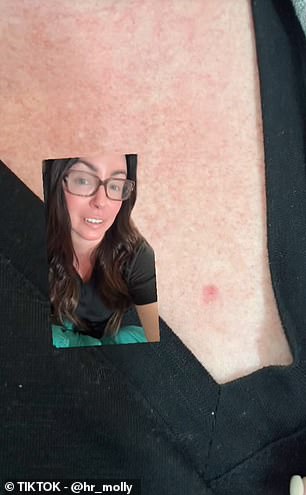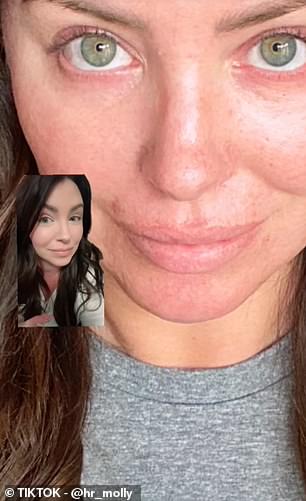I thought I was just prone to bug bites – it turns out I had SKIN CANCER nine times
A woman who thought she only had acne and insect bites turned out to have skin cancer nine times.
Molly, who goes by the name HR_Molly on social media, first thought she had an insect bite on her leg. But when it didn’t go away, she raised the alarm.
“I actually started to get a pit in my stomach that this could be skin cancer,” she said in a series of TikTok videos in July, which have been viewed more than a million times.
Molly sought help from a dermatologist, who said she had nothing to worry about. But when she brought up a spot on her lip that wouldn’t go away, the diagnosis changed.

Molly, who goes by HR_Molly on TikTok, shared a series of videos this summer explaining how she thought pimples on her skin were just acne or bug bites. It turned out to be skin cancer
“That’s probably skin cancer,” he said. “I wasn’t mentally prepared for having shock in my face, for them to have to take a biopsy,” Molly said.
“It was scary and a bit mentally traumatizing.”
Since then, she has had basal cell carcinoma skin cancer, the same cancer that First Lady Jill Biden had removed earlier this year, nine times from her face, ears, back, legs, chest and abdomen. This form of skin cancer is easily treatable and rarely fatal.
Molly now warns others not to ‘skip the dermatologist’, regardless of skin color or the amount of exposure your skin is exposed to.
“You don’t need a lot of sun exposure to get skin cancer,” she said.
“Regardless of skin color or family history, consult a dermatologist if you have access to one.”
Although sun exposure is the leading cause of skin cancer, Molly said she has only used tanning beds a few times and hardly spent any time in the sun.
She believes her heritage, which is part German, Irish and Native American, may have predisposed her to the condition.
Skin cancer is most common in fair skin, although a 2022 study in the Journal of the American Academy of Dermatology showed that American Indians and Alaska Natives had significantly higher rates of skin cancer such as melanoma compared to other minority groups.
“Your genetics loads the gun and your environment pulls the trigger,” Molly said.
There are approximately 5.4 million cases of skin cancer in the US each year, with 9,500 people dying from the disease.
Molly’s cancer, basal cell carcinoma, is the most common form of cancer in the US, with 3.6 million cases reported annually.


Molly has had basal cell carcinoma nine times in different places, including her face, ears, back, legs, chest and stomach
These arise from the uncontrolled growth of basal cells, which are located at the bottom of the epidermis, the outermost layer of the skin.
In Molly’s case, her cancer manifested as acne or insect bites, but it can take different forms. In most cases, basal cell carcinoma appears as a slightly transparent bump on the skin.
According to the Mayo Clinic, it can also look like a brown, black or blue lesion, a scaly patch or a scar-like lesion.
“Not all skin cancer will look like mine,” Molly said.
After her dermatologist noticed the first case of skin cancer, Molly underwent six-and-a-half-hour Mohs surgery.
Mohs surgery is performed on an outpatient basis and usually takes several hours. Many patients remain awake for the surgery, which only requires local anesthesia to numb the area.
The goal of a Mohs procedure is to cut away as much cancerous skin tissue as possible while causing as little damage as possible to surrounding healthy tissue. It is a gradual process and layers of skin are removed step by step.
First, the surgeon uses a scalpel to remove the cancerous skin tissue at the surface level, with the understanding that there may be more cancerous tissue beneath the surface. Skin cancer is like an iceberg. Most of it is usually hidden beneath the surface.
The surgeon maps where on the body the cancerous tissue has been removed, takes that tissue sample to the laboratory, stains it and cuts it into sections. Specialized technicians place these tissue samples on microscope slides to examine them under the microscope.
The doctor carefully examines the edges of each piece of tissue for signs of residual cancer. If the surgeon finds cancer cells under the microscope, their location is marked on the map.
The process is repeated until the doctor cannot find evidence of cancer in the tissue sampled.
Mohs surgery is performed more than 876,000 tumors every year in the US. It’s successful 99 percent of the time.
Molly’s cancer has returned eight more times in different parts of her body. To reduce scars, she uses microneedling, laser treatment, facials and Botox.
“I’ve had a lot more skin cancer since then,” she said. “It’s always like, ‘Is it a pimple? Is it a bug bite? Is it an ingrown hair?’
She avoids going outside during peak UV times, which are usually between 10am and 4pm, and always wears sunscreen outside.
